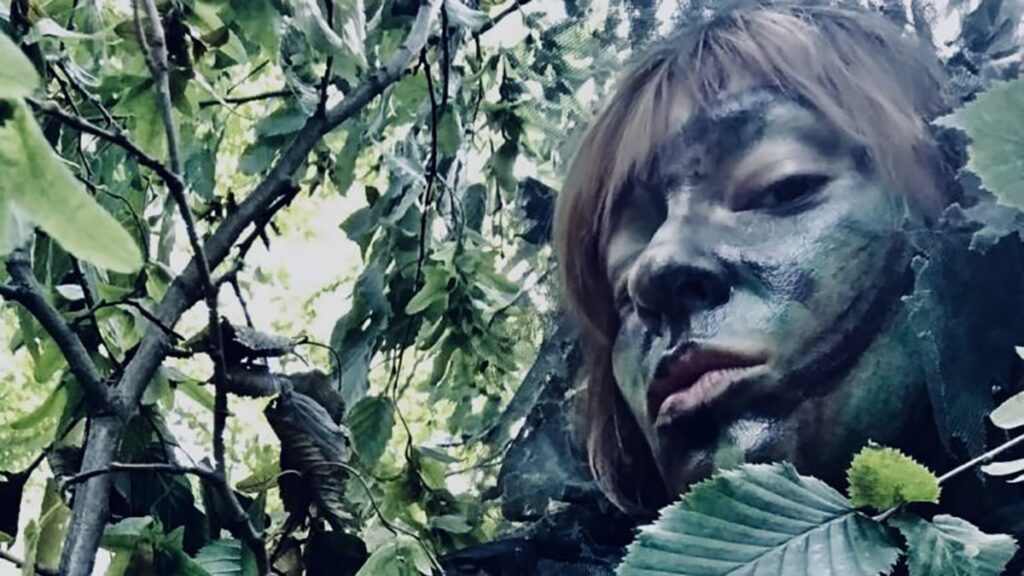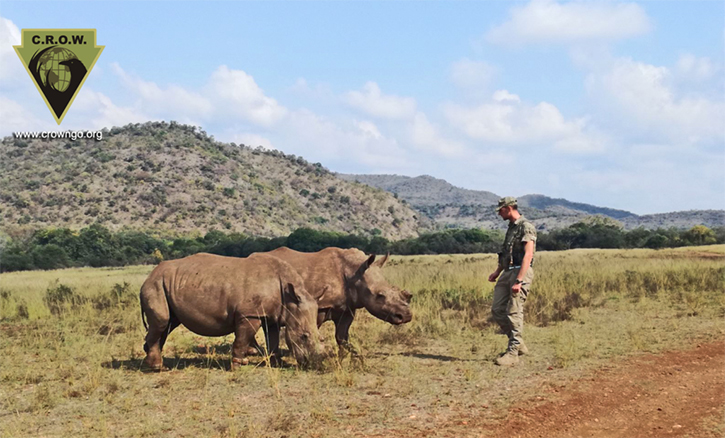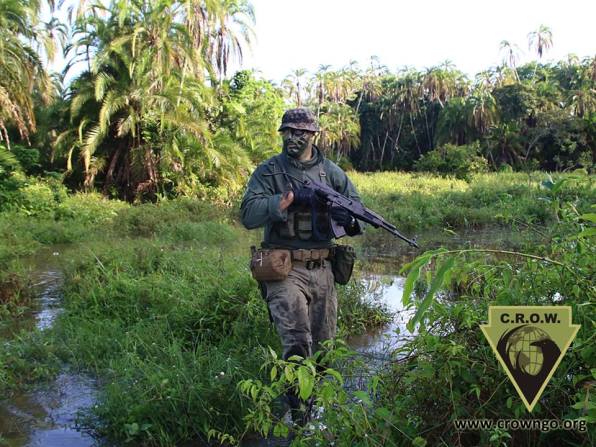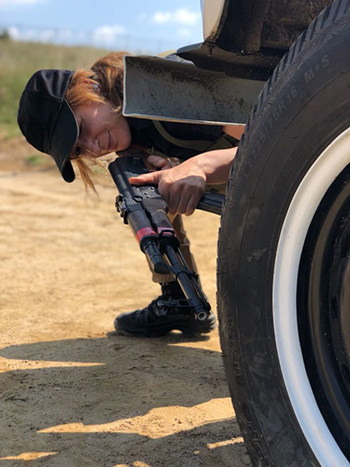You know me by my passion and dedication for the Art of Tracking, but few know about my commitment to wildlife conservation as a Ranger. This is my experience from an anti-poaching course where I learned the art of hunting man.
by Kyt Lyn Walken, contributing writer
“…A single tracker that points out a direction or sector of a fugitive, can within minutes have saved the work of hundreds of personnel trying to catch a glimpse of the person in any direction…”
– Sign and the Art of Tracking, Christian Nellmann, Jack Kearney, and Stig Nårstad

Why Anti-Poaching Training
I consider anti-poaching training to be an ideal complement to my skills as a tracker, as tracking represents a real cornerstone in any Ranger’s base of knowledge. But let’s take a step back in order to understand why I decided to enroll in an anti-poaching course. A book, as often happens for me, paved the way:
A Guide to Support Law Enforcement and Anti-Poaching Operations by Christian Nellemann and the mighty Master Tracker Jack Kearney (already author of one of the best manuals ever layered on this topic, Tracking: A Blueprint for Learning How).
“A guide to support law enforcement and anti-poaching operations” is clear and effective in its explanation. The book contains valuable information on the effective use of the art and science of operations against poaching. It is aimed both at identifying animals (primarily species at risk of extinction), and at identifying – and stopping – poachers. Sometimes – dead in their tracks!
In recent decades we have witnessed a disastrous increase the already bloody chapter of poaching, mainly linked to African and Asian areas. As I always felt an intimate connection with wildlife, I noticed a worrying increase of new articles on the danger of extinction for several animal species like rhinos, pangolins, tigers, koalas, and more.
Conservation Rangers Operations Worldwide (CROW)
My choice to take part in the Conservation Ranger Course, promoted by Conservation Rangers Operations Worldwide (CROW), was based in the belief that tracking can, for all intents and purposes, would provide a valuable contribution to anti-poaching operations. I mean, both in tracking endangered species in order to monitor them, but also for tracking – and hunting – poachers themselves.

I had confidence in CROW, because 1) it is a real non-governmental organization (NGO), a registered 501(c)(3) in the US, so I knew it did not have particular motives beyond conservation efforts; and 2) because it was founded by a group of individuals with effective and practical experience achieved in anti-poaching.
Plus, CROW is the only NGO in the world which provides free training to local Rangers. These are the people who know their own land best, and who often struggle from a lack of the following skills:
- remote medicine,
- tactical medicine, and
- survival and tracking skills.
The last bullet should not surprise you, as the young African generations often happen not to own any ability in building an improvised shelter and/or reading tracks. The first two bullets should not be a surprise, either. Those are, after all, why the Hesperian’s manuals were published: Where There is No Doctor and Where There is No Dentist.
Additionally, C.R.O.W. personnel form and train future Rangers in developing the necessary skills to support the conservation of species threatened by extinction through a two-week course. The course is layered in various modules, providing a 360° preparation thanks to a pool of international instructors with proven experience in anti-poaching, specifically in high-risk areas and environments, like the Democratic Republic of Congo’s inhospitable jungle.
So, I made the decision to attend to the entire program, as I was eager to learn the effectiveness of the Rangers’ operation in all its aspects, especially in reading the tracks and applying a slightly different approach, the so-called “South African Tracking Method,” which I will explain you a little further.
Last but not least, the possibility of receiving a complete training as a Conservation Ranger intrigued me for the possibility to expand my background as a tracking instructor, not to mention learning the unique aspects of training and deployment in Africa.

How to Become a Certified Conservation Ranger
The course, held from July 8th to 22nd at a facility in Poland, turned out to be an educational experience of the highest level, not to mention the outstanding caliber of the program itself. It was divided into ten modules, all related to each other so as to constitute a reasoned and practical path in the formation and training of future Rangers.
My classmates were all from different countries (Poland, Holland, Scotland, Lebanon, and France). This diversity of origin allowed for the creation of a close-knit and willing group to work together and help each other on the long evening study sessions.
Ranger Training Modules
Days 1-2: The first two modules, held in the classroom, dealt with animal behavior, endemic and environmental diseases, medical protocols, general medicine, and tactics.
Day 3: On the third day, through a quick transfer to the nearby woods, the instructor, throughout targeted exercises, taught tactical and remote medicine.
Days 4-5: The fourth and fifth days focused on the fundamental notions of survival (either for Savannah either for the jungle), and Orienteering and Tracking. The latter focused on the theoretical parts, carried out under almost non-stop rain, and were frequently broken up by individual and group exercises to strengthen the notions learned (read Map Reading and Land Navigation for your own training on this).
Additional Days: In the following days, the full focus was on defense and arresting techniques, essential teachings in order to be able to properly deal with high-risk situations. In this same perspective, the following days dedicated to the safe handling of the shotgun and the AK-47 (the most common weapons in Africa), which then resulted in a full day at the shooting range. There, weapon handling procedures used by special forces of different nations were taught, and all were “aimed” at being consistent and effective in the operational context of the Rangers.
Final Days: In the last leg of the course, the training focused on standard operating procedures, allowing, through uninterrupted exercises, to refine the ability to work as a team, and maximize the speed at which we could carry out procedures. The days dedicated to the creation of the right observation post, to the understanding of the ambush techniques most appropriate to the context, as well as to checkpoints. There was also instruction on effective camouflaging, expanding on the previous teachings.

The course ended with a 3.5 hour walk with about 25 kg (55lb) per backpack that allowed us to understand the harsh reality of patrolling, and finally with a day dedicated to training on vehicles.
On Sunday 22nd June, at the end of an exams (written and practical lasting about six hours), the new Rangers obtained their certificate together with the possibility of a concrete deployment in countries where the need for trained and dedicated personnel is more urgent.
South African Tracking Method

My desire to make a concrete contribution through the Art of Tracking to the fight against poaching has certainly been strengthened thanks to this course. I have become more aware, more mature, more respectful of risks, and more determined to work in the field. I also discovered a brand new approach to tracking, certainly more close to tactical tracking than to forensic.
The South African Tracking Method, in fact, has been essentially developed by Senior Rangers who are active in the frantic fight against poachers and it combines elements of tactical tracking (for example, team formations, hand signals, stealth approach and so on) to the necessity of moving fast in order to:
- remove snares (traps made of rusty iron, most of the time) and free potential animals trapped in them,
- patrol the fences of reserves and parks to collect data on possible illegal infiltration,
- prevent poachers activities, and
- arrest poachers.
In fact, by working only on conclusive tracks (with this, I mean to proceed fast on the trackline by following macro evidence, avoiding to lose precious time) a Tracker can cut the time/distance gap with the poachers. This is a tremendous part of preventing further crimes.
Plans for Future Deployment to Africa
Being a Certified Ranger means being in the field and gaining more knowledge and experience through patrolling, witnessing harsh realities, and learning to face dangers. Covid-19 keeps me from this temporarily. In fact, I was getting to know the country of my deployment when all started.
Conservation Rangers Operations Worldwide’s opportunities are now limited to spreading awareness, creating new Rangers in Europe, and retraining existing Rangers in order to always be ready.
We have ongoing collaborations with very important parks and reserves in Kenya, Congo DRC, Eswatini, and other states. We can’t wait to get back on the field and do our part to preserve animals and increase awareness in local communities.


3 comments
interested in crow ranger training in Poland. would like some information when there are courses in poland again.
J. Van de kraak (Netherlands)Thanks.
Hi! I passed your request to C.R.O.W. Staff; they should already have sent you all the details. Cheers!
Thanks, kyt lyn walken.i got the information about the training course in italy.